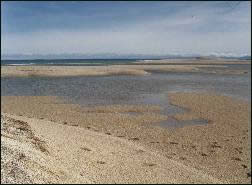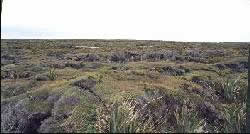Waituna Farmers United - the farmers' perspective - |
|
|
|
|
|
|
A case study By Brian Rance & Wynston Cooper, DOC, New Zealand Waituna Wetlands comprise an area of approximately 3,556ha situated on the southern coast of the South Island of New Zealand. The wetlands encompass the Waituna Lagoon along with adjacent peatlands, numerous ponds/lakes and coastline forming part of a larger complex of estuaries and lagoons within the Southland area.
Conservation of flora and fauna, and protection of wildlife are the primary uses of the wetland. However, other uses include sport fishing (for Brown Trout Salmo trutta) and game bird shooting. Much of the surrounding area is used for pastoral agriculture.
Notable endemic taxa include:
Fish:
Giant Kokopu Galaxias argenteus; National status: vulnerable
Birds:
New Zealand Shoveler Anas rhynchotis variegata; uncommon endemic subspecies
Plants:
Pingao Desmoschoenus spiralis
Aside from these species of special significance, the area supports a large diversity of birds, native fish, invertebrates and plants. Seventy six species of birds have been recorded, including both international and internal migratory waders. A significant aspect of the migratory wader population is the number of rare species (by New Zealand standards) that have been recorded in the reserve. These include Mongolian Dotterel Charadrius mongolus, Grey Plover Pluvialis squatarola, Marsh Sandpiper Tringa stagnatilis, Sanderling Calidris alba and Asiatic Whimbrel Numenius phaeopus variegalus. The wetlands also serve as an important moulting refuge for the New Zealand Shoveler. Native fish species include several endemic species some of which are rated as vulnerable. Many of the insects and some plants are typically subalpine species. Over 80 species of moth alone have been found in the Awarua Bay/Waituna Wetlands complex and the area is the type locality for a number of species of moth, some of which are not known to occur elsewhere. The diverse flora of the area includes the presence of the interesting cushion bog vegetation and sand ridge plant associations (Pingao, Coastal Tussock and locally uncommon species of mat-daisy).
The wetland, which is Crown-owned and managed by the Department of Conservation, was gazetted as a Scientific Reserve in 1983. Entry to the reserve is not restricted, but the relative isolation and difficulty of access ensure minimum disturbance. Monitoring continues on lagoon levels, effects of past fires and the impact of nesting gulls on the cushion bog vegetation. There are also bi-annual wading bird counts undertaken at Waituna Lagoon.
The Wetlands of Ecological and Representative Importance database gives the wetland a ranking of international importance and the wetland was designated a Ramsar site in 1976. The Department of Conservation is investigating the expansion of this Ramsar site to include additional wetland areas.
There are three major threats to the wetland:
Fires - there have been several large fires in adjacent peatlands in recent years;
in the area surrounding the wetland, an intensification of land use including draining, ploughing and sowing grass influences water quality;
exotic weed species - Gorse Ulex europaeus, Broom Cytasus scoparius and Spanish Heath Erica lusitanica are found in peripheral areas and are spreading within the wetland.
When the sea outlet from the lagoon is blocked during periods of high rainfall, the water floods back into marginal vegetation. This is a desirable feature for many of the reserve's botanical features which remain because of the occasional flooding of areas and maintenance of a high water table. If this occurs during July-November it can stimulate the breeding activity of Black Swan to a marked degree. However, it can also be detrimental for other species such as waders, as the mudflats used for feeding are not exposed, or for terns, oystercatchers and stilts when the small islands they favour as nesting sites are submerged. Blocking of the inlet also causes drainage problems on some farms close to the lagoon, so a management regime exists whereby periodically the bar is artificially opened to the sea.
|

